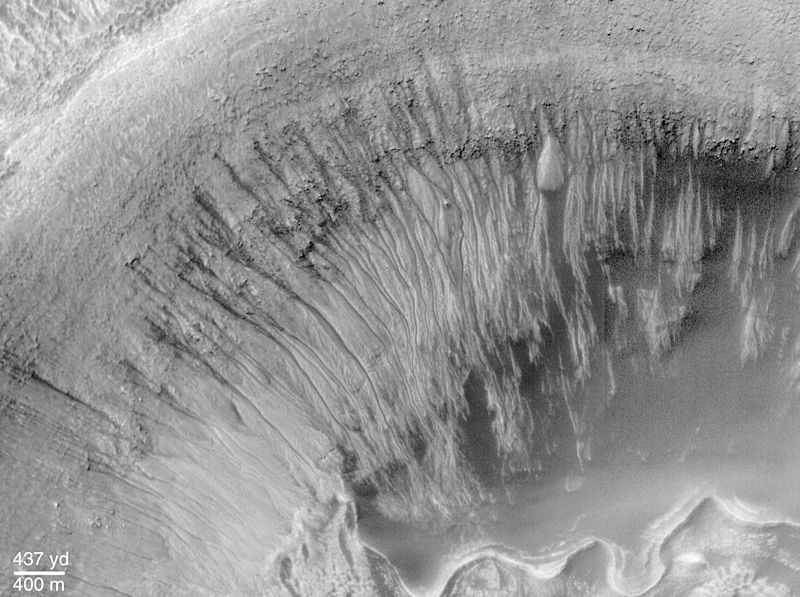File:Evidence for Recent Liquid Water on Mars (9464667825).jpg

Original file (2,133 × 1,593 pixels, file size: 1.3 MB, MIME type: image/jpeg)
Captions
Captions
Summary edit
| DescriptionEvidence for Recent Liquid Water on Mars (9464667825).jpg |
Newton Crater is a large basin formed by an asteroid impact that probably occurred more than 3 billion years ago. It is approximately 287 kilometers (178 miles) across. The picture shown here (top) highlights the north wall of a specific, smaller crater located in the southwestern quarter of Newton Crater (above). The crater of interest was also formed by an impact; it is about 7 km (4.4 mi) across, which is about 7 times bigger than the famous Meteor Crater in northern Arizona in North America. The north wall of the small crater has many narrow gullies eroded into it. These are hypothesized to have been formed by flowing water and debris flows. Debris transported with the water created lobed and finger-like deposits at the base of the crater wall where it intersects the floor (bottom center top image). Many of the finger-like deposits have small channels indicating that a liquid, most likely water, flowed in these areas. Hundreds of individual water and debris flow events might have occurred to create the scene shown here. Each outburst of water from higher up on the crater slopes would have constituted a competition between evaporation, freezing, and gravity. The individual deposits at the ends of channels in this MOC image mosaic were used to get a rough estimate of the minimum amount of water that might be involved in each flow event. This is done first by assuming that the deposits are like debris flows on Earth. In a debris flow, no less than about 10% (and no more than 30%) of their volume is water. Second, the volume of an apron deposit is estimated by measuring the area covered in the MOC image and multiplying it by a conservative estimate of thickness, 2 meters (6.5 feet). For a flow containing only 10% water, these estimates conservatively suggest that about 2.5 million liters (660,000 gallons) of water are involved in each event; this is enough to fill about 7 community-sized swimming pools or enough to supply 20 people with their water needs for a year. The Mars Orbiter Camera (MOC) high resolution view is located near 41.1S, 159.8W and is a mosaic of three different pictures acquired between January and May 2000. The MOC scene is illuminated from the left; north is up. Image # : PIA01039 |
| Date | |
| Source | Evidence for Recent Liquid Water on Mars |
| Author | NASA on The Commons |
| Permission (Reusing this file) |
NASA on The Commons @ Flickr Commons |
Licensing edit
This image was taken from Flickr's The Commons. The uploading organization may have various reasons for determining that no known copyright restrictions exist, such as: No known copyright restrictionsNo restrictionshttps://www.flickr.com/commons/usage/false
More information can be found at https://flickr.com/commons/usage/. Please add additional copyright tags to this image if more specific information about copyright status can be determined. See Commons:Licensing for more information. |
| This image was originally posted to Flickr by NASA on The Commons at https://flickr.com/photos/44494372@N05/9464667825. It was reviewed on 27 September 2015 by FlickreviewR and was confirmed to be licensed under the terms of the No known copyright restrictions. |
27 September 2015
File history
Click on a date/time to view the file as it appeared at that time.
| Date/Time | Thumbnail | Dimensions | User | Comment | |
|---|---|---|---|---|---|
| current | 19:29, 27 September 2015 |  | 2,133 × 1,593 (1.3 MB) | Sumita Roy Dutta (talk | contribs) | Transferred from Flickr via Flickr2Commons |
You cannot overwrite this file.
File usage on Commons
There are no pages that use this file.
Metadata
This file contains additional information such as Exif metadata which may have been added by the digital camera, scanner, or software program used to create or digitize it. If the file has been modified from its original state, some details such as the timestamp may not fully reflect those of the original file. The timestamp is only as accurate as the clock in the camera, and it may be completely wrong.
| Image title |
|
|---|---|
| Author | NASA/ Jet Propulsion Laboratory |
| Date and time of data generation | 00:00, 22 June 2000 |
| Credit/Provider | NASA |
| Source | NASA |
| Online copyright statement | http://www.nasa.gov/audience/formedia/features/MP_Photo_Guidelines.html#.Ue6Pwj3piSo |
| Short title |
|
| Width | 2,133 px |
| Height | 1,593 px |
| Pixel composition | Black and white (Black is 0) |
| Orientation | Normal |
| Number of components | 4 |
| Horizontal resolution | 200 dpi |
| Vertical resolution | 200 dpi |
| Software used | Adobe Photoshop CS6 (Windows) |
| File change date and time | 00:00, 22 June 2000 |
| Exif version | 2.21 |
| Date and time of digitizing | 00:00, 22 June 2000 |
| Color space | Uncalibrated |
| Unique ID of original document | D76ED6CD57D6BE0958FA01372EF4CFF6 |
| Date metadata was last modified | 06:34, 23 July 2013 |
| Copyright status | Copyright status not set |
| Keywords |
|
| IIM version | 4 |